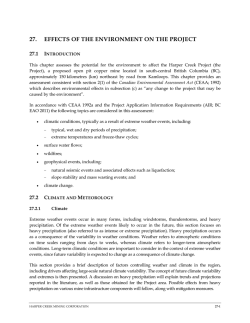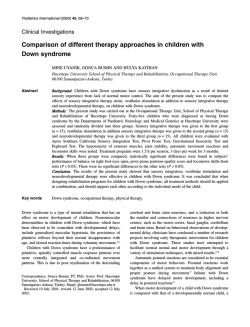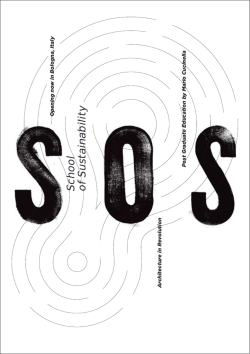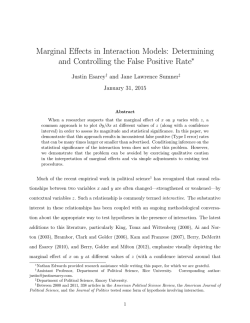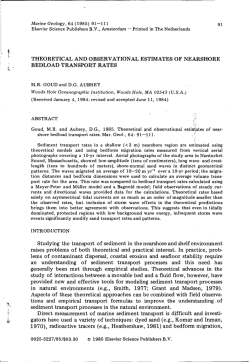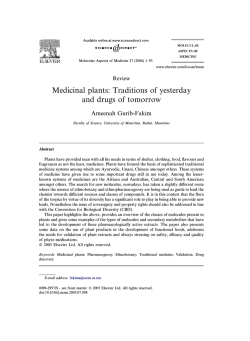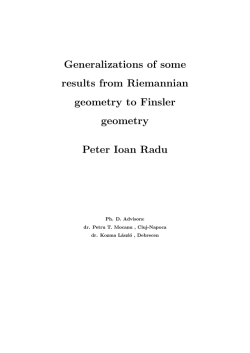
PDF (3.03 MB)
Home Search Collections Journals About Contact us My IOPscience Changes in observed climate extremes in global urban areas This content has been downloaded from IOPscience. Please scroll down to see the full text. 2015 Environ. Res. Lett. 10 024005 (http://iopscience.iop.org/1748-9326/10/2/024005) View the table of contents for this issue, or go to the journal homepage for more Download details: IP Address: 136.243.24.42 This content was downloaded on 06/02/2015 at 14:58 Please note that terms and conditions apply. Environ. Res. Lett. 10 (2015) 024005 doi:10.1088/1748-9326/10/2/024005 LETTER Changes in observed climate extremes in global urban areas OPEN ACCESS Vimal Mishra1,2,3, Auroop R Ganguly3, Bart Nijssen2 and Dennis P Lettenmaier2,4 RECEIVED 31 July 2014 1 2 ACCEPTED FOR PUBLICATION 3 23 December 2014 4 PUBLISHED 29 January 2015 Civil Engineering, Indian Institute of Technology(IIT), Gandhinagar, India Civil and Environmental Engineering, University of Washington, Seattle, USA Civil and Environmental Engineering, Northeastern University, Boston, USA Department of Geography, University of California, Los Angeles, USA E-mail: [email protected] Keywords: urban areas, climate extremes, heat wave, precipitation extremes Content from this work may be used under the terms of the Creative Commons Attribution 3.0 licence. Any further distribution of this work must maintain attribution to the author (s) and the title of the work, journal citation and DOI. Supplementary material for this article is available online Abstract Climate extremes have profound implications for urban infrastructure and human society, but studies of observed changes in climate extremes over the global urban areas are few, even though more than half of the global population now resides in urban areas. Here, using observed station data for 217 urban areas across the globe, we show that these urban areas have experienced significant increases (pvalue <0.05) in the number of heat waves during the period 1973–2012, while the frequency of cold waves has declined. Almost half of the urban areas experienced significant increases in the number of extreme hot days, while almost 2/3 showed significant increases in the frequency of extreme hot nights. Extreme windy days declined substantially during the last four decades with statistically significant declines in about 60% in the urban areas. Significant increases (p-value <0.05) in the frequency of daily precipitation extremes and in annual maximum precipitation occurred at smaller fractions (17 and 10% respectively) of the total urban areas, with about half as many urban areas showing statistically significant downtrends as uptrends. Changes in temperature and wind extremes, estimated as the result of a 40 year linear trend, differed for urban and non-urban pairs, while changes in indices of extreme precipitation showed no clear differentiation for urban and selected non-urban stations. 1. Introduction For the first time, more than half of the global population resides in urban areas (Grimm et al 2008), a number that is expected to increase to 60% by 2030, and 70% by 2050 (World Health Organization 2014). Between 1900 and 2000, the number of urban areas with more than one million population increased from 17 to 388 (Millennium Ecosystem Assessment 2003). Urban areas are centers of wealth, human population, and built infrastructure and are considered by some to be ‘first responders’ to climate change (Rosenzweig et al 2010). Moreover, cities are the fundamental units for climate change mitigation and adaptation (Georgescu et al 2014). Climate variability and change can exert profound stresses on urban environments, which are sensitive to heat waves, droughts, and changes in the frequency and magnitude of flash floods (Rosenzweig et al 2011). © 2015 IOP Publishing Ltd Temperature-related climate extremes have been shown to be strongly related to human health (Patz et al 2005, Hayhoe et al 2010, Hondula et al 2014). Extreme precipitation events, which are projected to increase in a warming climate (Allen and Ingram 2002, O’Gorman and Schneider 2009, Min et al 2011a), cause disproportionate damage to urban transportation systems, and pose challenges to urban stormwater drainage systems (Schreider et al 2000, Rosenberg et al 2010, Mishra et al 2012a). In the recent past, flood disasters have affected many large urban areas including Bangkok (2011), Brisbane (2011), Guangdong (2007), Mumbai (2005), and Dresden (2002) (Liao 2012). In addition to temperature and precipitation extremes, extreme wind storms can cause enormous damage to urban areas (Munich Re 1999, Swiss Re 2001). Despite the potentially large and costly damages from climate extremes in urban areas, most Environ. Res. Lett. 10 (2015) 024005 V Mishra et al observation-based studies have focused on large spatial extents (i.e. national, regional, or continental) (Easterling et al 2000, Zhang et al 2005, Alexander et al 2006, Min et al 2011, Donat et al 2013). For instance, Donat et al (2013) analyzed trends in climatic extremes using a gridded dataset, but did not evaluate changes in extreme events in urban areas specifically. Studies that address climate extremes in global urban areas and disparities in urban and non-urban areas have been far fewer (Ashley et al 2005, Hallegatte et al 2007). This may be in part because of complications in obtaining high quality observations from station data or developing gridded datasets using stations within the vicinity of urban areas (Mishra and Lettenmaier 2011). Many studies have shown the influence of urbanization on meteorological forcing (Zhang et al 2009, Kishtawal et al 2010, Shepherd et al 2010a, 2010b, Chen et al 2011), which is not the focus of this work. Here we analyze observed changes in climate extremes in global urban areas during the last four decades (1973–2012) using daily data from selected Global Summary of the Day (GSOD) stations. We hypothesize that globally, observed climate changes in urban areas, notwithstanding major land use/ cover change over the last 40 years, are dominantly due to large scale changes, rather than local land cover. We report changes in daily temperature and precipitation extremes as well as changes in the frequency of extreme windy days in 217 urban areas across the globe. Moreover, we discuss disparities in changes in climate extremes in 142 paired urban and non-urban stations. 2. Analysis approach We obtained daily observations for precipitation, air temperature (mean, maximum, and minimum), and mean wind speed from the GSOD data produced by the National Climatic Data Center (NCDC). GSOD data are quality controlled by NCDC through automated quality checks. Most random errors are removed and further corrections are applied to control for changes in instrumentation, station moves, and changes in time of observation (ftp://ftp.ncdc.noaa. gov/pub/data/gsod/readme.txt, accessed on 1 December 2013). The GSOD data are updated on a near realtime basis with a lag of 1–2 days. Historical data are available from 1929; however, we selected the period 1973–2012 for analysis as this period has the largest number of relatively complete and consistent records. Further details on the GSOD data can be obtained from the website http://www.climate.gov/globalsummary-day-gsod. We identified all urban areas globally (about 650) with population greater than 250 000 using the ESRI Arc-GIS shapefile (ESRI 2008, http://www.baruch. cuny.edu/geoportal/data/esri/esri_intl.htm, assessed on 20 November 2013) and selected GSOD station(s) 2 located within 25 km of these urban areas. GSOD records for these stations were checked for record length and missing values. Our selection of urban areas based on population was further verified with urban extent derived using the MODIS data (Schneider et al 2009). Schneider et al (2009) identified urban areas as built environments including non-vegetative and human constructed elements. They were identified using supervised classification of MODIS 1 km land cover data (see Schneider et al (2009) for details). This comparison shows that urban areas selected based on population fall within the urban extents derived using the satellite based dataset (figures S9– S14). We removed all stations that had one or more years of missing data or more than 10% missing values in any year during the period of 1973–2012. After identifying candidate stations based on the proximity criteria, and applying the quality checks, we were left with 217 stations (table S2) with relatively complete records for the period 1973–2012, most of which were located at airports close to urban areas (see supplemental table S1, available at stacks.iop.org/ERL/10/ 024005/mmedia). Furthermore, about 90% of the stations are within 15 km of the center of the urban area they represent. We analyzed daily extremes for temperature, precipitation (24 h totals), and wind. For temperature extremes, we analyzed heat and cold waves as well as extreme hot days and nights. Heat waves were defined as periods during which the daily maximum temperature stayed above (below) the empirical 99th-percentile (estimated for the period 1973–2012) consecutively for six or more days. Similarly cold waves were identified using daily minimum temperatures. The frequency of extreme hot days was estimated using the 99th-percentile of daily maximum temperatures, also for the period 1973–2012. The frequency of extreme hot nights was identified using the 99th percentile of daily minimum temperatures. For precipitation extremes, annual maximum precipitation, frequency of precipitation extremes, and fraction of total precipitation occurring due to extreme events were estimated for each year during the period of 1973–2012. Annual maximum precipitation was defined as the maximum daily precipitation in each year. To estimate the frequency of extreme precipitation events, we used the 95th-percentile of daily precipitation for rain days (precipitation >1 mm d−1) during the 1973–2012 reference period. We selected the 95th percentile threshold for extreme precipitation events because the 99th percentile threshold leads to some years without extreme precipitation events, which makes detection of trends difficult. We carefully evaluated the influence of the selection of specific thresholds on trends of extreme precipitation events and found that the nature of the trends remains the same with a higher or lower threshold. The number of days with precipitation greater than or equal to the 95th-percentile was used as an index for extreme Environ. Res. Lett. 10 (2015) 024005 V Mishra et al precipitation in each year. The fractional contribution from the extreme precipitation events to the total precipitation for each year was computed using the same 95th-percentile threshold. Extreme windy days were defined as days with a daily mean wind speed that exceeded the 99th-percentile threshold of daily mean wind speed. We estimated changes in each of the statistics using the non-parametric Mann–Kendall (Mann 1945) trend test and Sen’s slope method (Sen 1968). The Mann–Kendall method has been widely used for trend detection in hydrologic and climate data (Mishra and Lettenmaier 2011, Yue and Wang 2002). We also computed field significance (Livezey and Chen 1983) using the method described in Yue and Wang (2002). The statistical significance of changes in the mean and distribution was tested using the two sided Ranksum and Kolmogorov and Smirnov (KS)(Massey 1951) tests, respectively at 5% significance level. We divided the 217 locations into six regions based on the number of stations in each region (figure 1(a)): Africa (AF), East Asia (EA), Europe (EU), India (IN), North America (NA), and South America (SA) and applied the field significance test on a regional basis. Changes in climatic extremes were estimated by multiplying the linear trend obtained from the Mann–Kendall test with the length of the analysis period (i.e. 40 years). To understand differences in precipitation and temperature extremes, we identified paired urban and non-urban stations based on population density as described in Mishra and Lettenmaier (2011). We obtained the gridded population density (1 km spatial resolution) from the Global Urban–Rural Mapping Project (GURMP v3) for the year 2000 from the CIESIN’s web site (http://sedac.ciesin.columbia.edu/gpw/ global.jsp, accessed on 8 December 2013). Stations with population density less (more) than 200 (500) person/km2 were identified as non-urban (urban) stations. We successfully verified urban and non-urban pairs based on urban extents derived from MODIS (figure S15). Zhou et al (2013) reported the influence of spatial clustering of stations on urban-heat island effect; however, our aim was to find out disparities in trends between stations located in urban and paired non-urban areas. We identified 142 urban and nonurban station pairs with median population densities 2540 and 99 persons/km2, respectively. For each urban station (out of 142), a non-urban station (based on the quality and completeness of the dataset) was selected using distance thresholds of 50, 75, 100, 125, 150, and 200 km from the urban station location. We excluded non-urban pairs that exceeded the 200 km threshold to avoid large changes in climate and topography. As much as possible, we selected pairs that are not affected by geographical disparities associated with elevation, location, and climate. However, to avoid these differences entirely, the station density in urban and non-urban areas needs to be greatly improved. 3 3. Results 3.1. Changes in temperature extremes Figure 1 shows changes in heat and cold waves globally during the reference period (1973–2012). Because heat and cold waves do not occur every year, we evaluated changes using the pooled data, where mean heat waves for each year were estimated for all the urban areas in a given region. Pooled time series of global urban areas showed statistically significant increases in the number of heat waves per urban area during the last four decades (change = 0.32 heat waves per urban area during the reference period, p < 0.05 on normalized data; figure 1(b)). During the last 40 years, the five years with the largest number of heat waves (aggregated over all regions) were 1998, 2009, 2010, 2011, and 2012. Taken over all 217 stations, the average number of heat waves by decade exhibited a consistent increase with the highest number of heat waves occurring during the most recent decade (2003–2012; figure 1(c)). Figure 1(d) shows that the frequency of cold waves generally declined. For instance, the pooled cold waves showed a statistically significant (p-value <0.05) decline of 0.16 cold waves per urban area during the reference period. The five years with the largest number of cold waves were 1973, 1974, 1976, 1981, and 1983. The average number of cold waves by decade declined until 1993–2002, followed by a slight increase in the number of cold waves during the most recent decade (2003–2012). Median changes over all sites showed increases in heat waves and declines in cold waves (figures 1(f) and (g)). Increases in heat waves were field significant for AF, EA, EU, and NA. Increases in IN and SA were not field significant (figure 1(f)). Field significant decreases in cold waves were found in NA (figure 1(g)), however, decreases in cold waves in EU were not field significant. No statistically significant trends in the number of cold waves were detected in the remaining regions. Changes in the frequency of extreme hot days (above 99th-percentile) are shown in figure 2. During the reference period, the number of extreme hot days increased significantly at many sites (figure 2(a)). However, a few urban areas located in EA showed significant declining trends. About 48% of the sites showed statistically significant increases (figure 2(b)). On the other hand, fewer than 2% of the total urban areas experienced significant declines in the frequency of extreme hot days. Median increases of eight days in the frequency of extreme hot days were found for urban areas with statistically significant uptrends (figure 2(c)). Moreover, all regions showed field significance for increases in the frequency of extreme hot days (figure 2(d)) with median change (estimated using average linear trend multiplied by 40 years) ranging from three to nine days between 1973 and 2012. Similar to increases in the number of extreme hot days, the number of extreme hot nights (estimated from daily minimum temperature data) increased Environ. Res. Lett. 10 (2015) 024005 V Mishra et al Figure 1. (a) Location of the selected urban areas (sites) and their population range, (b) pooled (over all stations) estimates of average number of heat waves per station per year over the reference period 1973–2012, (c) decadal variation in pooled estimates (over all sites) of average number of heat waves per year, (d) pooled estimates of average number of cold waves per year, (e) decadal variation in pooled estimates of average number of cold waves per year, (f) median change in pooled number of heat waves per year by region and globally (GL). In panels f and g solid bars represent field significant changes (at 5% significance level); open bars indicate lack of field significance. significantly in a majority of urban areas across the globe (supplemental figure S1(a)). About 63% of the urban areas experienced statistically significant increase in the frequency of hot nights (figure S1(b)). Between 1973 and 2012, a median increase of ten hot 4 nights was found in urban areas that showed significant increases (figure S1(c)). Increases in the number of hot nights were field significant in all the regions except for IN (figure S1(d)). Along with temperature extremes, a significant warming in mean temperature Environ. Res. Lett. 10 (2015) 024005 V Mishra et al Figure 2. (a) Changes in frequency (number) of extreme hot days per year (exceeding 99th percentile for the reference period 1973–2002), (b) percentage of sites showing positive (hollow red), significantly positive (solid red), negative (hollow blue), and significantly negative (solid blue) changes in extreme hot days per year, (c) median changes in frequency of extreme hot days per year (increasing non-significant open red; significantly increasing solid red; decreasing non-significant open blue; significantly decreasing solid blue), (d) median changes in extreme hot days by region; solid bars in (d) represent field significant trends; open bars are not field significant. In (a) positive (negative) and significantly positive (negative) changes are shown with red (blue) and filled red (blue) circles, respectively. Changes and their statistical significance (at 5% level) were estimated using the Mann–Kendall trend test. was found at a majority of urban areas across all seasons (figure S6). Moreover, a majority of the selected urban areas experienced significant changes in both mean and distribution of mean annual temperature estimated using the two-sided Ranksum and KS tests, respectively (figure S7). The majority of urban areas showed changes in both the mean and distribution of mean annual air temperature rather than just the distribution (figure S7). 3.2. Changes in extreme windy days Figure 3 shows changes (linear trend multiplied by the duration (40 years)) in the frequency of extreme windy days. The majority of sites experienced a significant (p < 0.05) decline in the number of extreme windy days during the last four decades (figure 3(a)). However, in each region a few sites showed increases. About 75% of the total urban areas showed significant declines in number of extreme windy days (figure 3(b)). On the other hand, statistically significant increases in extreme windy days occurred for less 5 than 10% of the sites. Between 1973 and 2012, median declines in the number of extreme windy days were about 20 days for urban areas with statistically significant changes (figure 3(c)). In all the regions except SA, results were field significant for declines in extreme windy days with the median ranging between 5 and 25 days during the period of 1973–2012. Our results also showed statistically significant declines in mean wind speed at many sites, which is consistent with trends in mean wind speed at the 925 mb level from the NCEP-NCAR reanalysis (figure S5). Moreover, these results are consistent with the findings of Vautard et al (2010) who reported declines in wind speed in continental areas with higher reductions in strong winds than in weaker winds. 3.3. Changes in extreme precipitation We evaluated changes in the frequency of precipitation extremes for the period of 1973–2012 (figure S22). In contrast to temperature related extremes, changes in precipitation extremes exhibited greater spatial Environ. Res. Lett. 10 (2015) 024005 V Mishra et al Figure 3. (a) Changes in frequency (number) of extreme windy days per year (exceeding 99th percentile of the reference period (1973–2012). (b) Percentage of sites with positive (hollow red), significantly positive (solid red), negative (hollow blue), and significantly negative (solid blue) changes, (c) median changes in frequency (number) of extreme hot days per year for sites with positive, significantly positive, negative, and significantly negative changes. (d) Median changes in extreme hot days by region. Solid bars in (d) represent field significant trends; hollow bars indicate lack of field significance. In (a) positive (negative) and significantly positive (negative) changes are shown with red (blue) and filled red (blue) circles, respectively. Changes and their statistical significance (at 5% level) were estimated using the Mann–Kendall trend test. variability (figures S22(a), S2(a), S3(a)). A number of sites in IN and SA showed statistically significant increases in the frequency of precipitation extremes, but most sites elsewhere did not experience statistically significant changes in the number of extreme precipitation events. Taken over all sites, 17% showed a statistically significant increase and less than 5% showed a statistically significant decrease (figure S22 (b)). Median changes in the number of extremes for sites with significant increases and declines were about the same (5% in both cases, figure S22(c)). Increases in the frequency of extreme precipitation events were field significant for only two regions (IN and SA; figure S22(d)). Many urban areas in EU experienced significant declines (estimated using linear trend multiplied by 40) in annual maximum precipitation over the reference period (figure S2(a)). On the other hand, a few urban areas in IN showed increases in annual maximum precipitation, which is associated with large scale climate variability (Ali et al 2014). More sites had 6 declines in annual maximum precipitation than increases (figure S2(b)), while about the same number (10%) showed statistically significant increases and decreases. The median over sites in AF, IN, NA, and SA showed positive median changes, whereas EA and EU showed negative median changes in annual maximum precipitation (figure S2(d)). EU showed a field significant decline in annual maximum precipitation, whereas changes were not field significant for any other region. These results showing declines or increases in annual maximum precipitation are based on a relatively small number of stations primarily located in the urban areas. Therefore, results based on gridded datasets over large areas of EU or IN for instance (e.g. Alaxender et al (2006) and Goswami et al (2006)) may be different from those reported here. Moreover, disparities in trends in different regions can be due to large scale climate variability. For instance, IN receives most of its annual precipitation during the monsoon (JJAS) season, which is strongly associated with sea surface temperature in the Pacific and Indian Ocean Environ. Res. Lett. 10 (2015) 024005 V Mishra et al Figure 4. (a), (b) Change in frequency (number) of hot days (above 95th percentile) for urban and paired non-urban areas for the period of 1973–2012, (c), (d) same as (a), (b) but for frequency of extreme windy days (above 95th percentile), (e) box plots showing changes in frequency of hot days in all urban and non-urban areas, and (f) same as (e) but for changes in extreme windy days. In (e), (f) numbers in red (blue) show urban/non-urban areas with positive (negative) changes while numbers in parenthesis show number of urban/non-urban areas with significant changes. regions (Goswami et al 2006, Mishra et al 2012b). On the other hand, European climate is strongly associated with western circulation which transports moist air from Atlantic to the European Land mass (van Ulden and van Oldenborgh 2006). Changes in the fraction of total precipitation contributed by extreme precipitation events were largely similar to those for annual maximum precipitation (figure S3). Field significant declines occurred for EU, while none of the other regions showed field significance. Precipitation extremes are more variable in space and time than are temperature extremes. For instance, Coumou and Rahmstorf (2012) reported that statistical detection of precipitation extremes remains a challenge due to their non-Gaussian behavior and localized spatial scales. Longer precipitation records in urban areas may provide more insights on changes in extreme precipitation events and their links with climate variability. 3.4. Changes in urban and non-urban pairs Figure 4 shows changes in the number of hot days and extreme windy days estimated using linear trend multiplied by the duration of 40 years for urban and non-urban pairs. Both urban and non-urban pairs experienced significant increases in the number of hot 7 days during the last four decades (figures 4(a) and (b)). However, stations located in non-urban areas showed somewhat lower increases in the number of hot days than those located in urban areas. Differences in changes in the number of hot days in urban and non-urban areas due to the urban heat island effect have been reported in many previous studies (Stone 2007, Stewart and Oke 2012). Out of the 142 pairs, 72 (62) urban (non-urban) areas showed statistically significant increases in number of hot days (figure 4(e)). A majority of urban and non-urban pairs showed declines in extreme windy days; however, stations located in eastern Asia, EU, and eastern United States showed differences in direction and magnitude of changes (figures 4(c) and (d)). Out of the 142 pairs, statistically significant declines occurred at 88 (64) urban (non-urban) stations, respectively (figure 4(f)). Fortuniak et al (2006) studied urban– rural contrasts in meteorological variables in Poland and found that wind speed at urban stations was lower by 39 and 34% during day and night-time, respectively. Differences in wind speed in urban and nonurban pairs can be associated with land surface conditions as well as localized meteorological conditions as reported in Fortuniak et al (2006) and Vautard et al (2010). Environ. Res. Lett. 10 (2015) 024005 V Mishra et al Changes in annual maximum precipitation and frequency of precipitation extremes for urban and non-urban pairs are compared in supplemental figure S8. Changes in extreme precipitation for urban and non-urban stations show no statistically significant difference. For instance, mixed changes were observed in annual maximum precipitation and frequency of extreme precipitation events for both urban and nonurban stations located in NA, EU, and EA (supplemental figures S8 (a) and (b)). Moreover, the number of urban/non-urban areas with significant increases/ declines in annual maximum precipitation and frequency of precipitation extremes were similar (supplemental figures S8 (e) and (f)). 4. Conclusions Many urban areas across the globe experienced statistically significant increases in the number of heat waves during the reference period 1973–2012. Taken over all sites, the largest number of heat waves has occurred during the most recent decade (2003–2012). Moreover, four of the five years with the largest number of heat waves are the last four years of the record (2009, 2010, 2011, and 2012). Many sites also experienced statistically significant declines in the number of cold waves. Statistically significant increases in the frequency of hot days and nights were detected at many sites, with almost half (48%) having statistically significant increases in the number of hot days, and almost 66% having statistically significant increases in the number of hot nights. Trends related to temperature related extremes are consistent with the findings of Donat et al (2013) who reported significant increases in heat waves and hot nights across the globe. Changes in temperatures extremes are largely driven by changes in both mean and distribution of air temperature (figure S7). Increasing and declining trends in temperature extremes may be associated with natural climate variability, anthropogenic climate warming, and land use/land cover (Kiktev et al 2003, Alexander et al 2009, Min et al 2011b, Avila et al 2012, Coumou and Rahmstorf 2012). Here we simply report the aggregate effect on urban extremes and have not attempted to quantify their separate contributions. The frequency of extreme windy days declined significantly in a majority of the urban areas, with almost 60% of the sites having statistically significant declines. All regions except SA were field significant for declines in the frequency of extreme windy days. Results from station data for extreme windy days are consistent with the NCEP-NCAR reanalysis data (figure S5). Declining trends in wind speed have been noticed in many studies (Vautard et al 2010, Guo et al 2011, McVicar et al 2012, Troccoli et al 2012) and have been largely attributed to changes in atmospheric circulation and 8 changes in land surface roughness driven by land cover changes. As compared with the prevalence of changes in indices related to extreme temperature and wind, precipitation extremes had statistically significant changes at far fewer sites, with only 17 and 10% of the sites experiencing statistically significant increases in the frequency of extreme precipitation events and annual maximum precipitation, respectively. Many previous studies demonstrated that climate warming will lead to more precipitation extremes (Christensen and Christensen 2003, Gutowski et al 2010, Min et al 2011c), however, consistent with the findings of Donat et al (2013), we found heterogeneous trends associated with extreme precipitation events. There were many urban areas with no trend in extreme precipitation events which highlights challenges in detection of trends related to extremes as described in Coumou and Rahmstorf (2012). Urban and non-urban pairs showed disparate changes for temperature and wind related extremes (generally more increases in temperature-related extremes, and more decreases in wind-related extremes in urban as compared to non-urban stations), and hence appear to be counter to our overall hypothesis that large scale climate drivers dominate changes in climate extremes. However, precipitationrelated extremes were similar at urban and non-urban pairs, suggesting a prominent role of large scale climate variability, consistent with our overarching hypothesis. However, for a few regions (i.e. EU and EA), differences in land cover and local factors appear to be important contributors to observed changes in wind and temperature related extremes. As compared with results of a similar analysis for the conterminous US (Mishra and Lettenmaier 2011), larger disparities in temperature extremes in urban and non-urban areas can be attributed to record length of the data as well as lesser number of stations available in nonurban regions. Our results have important implications for policy makers. For instance, increasing numbers of heat waves may lead to enhanced heat wave related mortality in urban areas (Coumou and Robinson 2013, Li et al 2013). Increased warming in urban areas will also have implications on residential heating and cooling demands (Frank 2005). Increases in precipitation extremes in urban areas will pose challenges for urban stormwater infrastructure. These implications argue for the importance of enhancing the density of climate stations in urban and surrounding non-urban areas to provide the baseline data that will be essential for climate change adaptation and decision making. Acknowledgments The data used in this manuscript can be obtained from Global Summary of the Day (GSOD) version 8, Environ. Res. Lett. 10 (2015) 024005 V Mishra et al National Climatic Data Center (ftp://ftp.ncdc.noaa. gov/pub/data/gsod/). The first author acknowledges partial funding from the Varahamihir Earth Science Fellowship and Expedition program funded by NSF (grant number 1029166) References Alexander L V, Uotila P and Nicholls N 2009 Influence of sea surface temperature variability on global temperature and precipitation extremes J. Geophys. Res. Atmos. 114 D18116 Alexander L V et al 2006 Global observed changes in daily climate extremes of temperature and precipitation J. Geophys. Res. Atmospheres 1984−2012 111(D5) Ali H, Mishra V and Pai D S 2014 Observed and projected urban extreme rainfall events in India J. Geophys. Res. Atmos. 119 12621–41 Allen M R and Ingram W J 2002 Constraints on future changes in climate and the hydrologic cycle Nature 419 224–32 Ashley R M, Balmforth D J, Saul A J and Blanskby J D 2005 Flooding in the future predicting climate change, risks and responses in urban areas Water Sci. Technol. Assoc. Water Pollut. Res. 52 265–73 Avila F B, Pitman A J, Donat M G, Alexander L V and Abramowitz G 2012 Climate model simulated changes in temperature extremes due to land cover change J. Geophys. Res. Atmos. 117 D04108 Chen F, Kusaka H, Bornstein R, Ching J, Grimmond C S B, Grossman-Clarke S, Loridan T, Manning K W, Martilli A and Miao S 2011 The integrated WRF/urban modelling system: development, evaluation, and applications to urban environmental problems Int. J. Climatol. 31 273–88 Christensen J H and Christensen O B 2003 Climate modelling: severe summertime flooding in Europe Nature 421 805–6 Coumou D and Rahmstorf S 2012 A decade of weather extremes Nat. Clim. Change 2 491–6 Coumou D and Robinson A 2013 Historic and future increase in the global land area affected by monthly heat extremes Environ. Res. Lett. 8 034018 Donat M G, Alexander L V, Yang H, Durre I, Vose R, Dunn R J H, Willett K M, Aguilar E, Brunet M and Caesar J 2013 Updated analyses of temperature and precipitation extreme indices since the beginning of the twentieth century: the HadEX2 dataset J. Geophys. Res. Atmos. 118 2098–118 Easterling D R, Meehl G A, Parmesan C, Changnon S A, Karl T R and Mearns L O 2000 Climate extremes: observations, modeling, and impacts Science 289 2068–2074 Fortuniak K, Kłysik K and Wibig J 2006 Urban–rural contrasts of meteorological parameters in Łódź Theor. Appl. Climatol. 84 91–101 Frank T 2005 Climate change impacts on building heating and cooling energy demand in Switzerland Energy Build. 37 1175–85 Georgescu M, Morefield P E, Bierwagen B G and Weaver C P 2014 Urban adaptation can roll back warming of emerging megapolitan regions Proc. Natl Acad. Sci. USA 111 2909–14 Goswami B N, Venugopal V, Sengupta D, Madhusoodanan M S and Xavier P K 2006 Increasing trend of extreme rain events over India in a warming environment Science 314 1442–5 Grimm N B, Faeth S H, Golubiewski N E, Redman C L, Wu J, Bai X and Briggs J M 2008 Global change and the ecology of cities Science 319 756–60 Guo H, Xu M and Hu Q 2011 Changes in near-surface wind speed in China: 1969–2005 Int. J. Climatol. 31 349–58 Gutowski W J Jr, Arritt R W, Kawazoe S, Flory D M, Takle E S, Biner S, Caya D, Jones R G, Laprise R and Leung L R 2010 Regional extreme monthly precipitation simulated by NARCCAP RCMs J. Hydrometeorol. 11 1373–9 Hallegatte S, Hourcade J-C and Ambrosi P 2007 Using climate analogues for assessing climate change economic impacts in urban areas Clim. Change 82 47–60 9 Hayhoe K, VanDorn J, Croley T II, Schlegal N and Wuebbles D 2010 Regional climate change projections for Chicago and the US Great Lakes J. Gt. Lakes Res. 36 7–21 Hondula D M, Vanos J K and Gosling S N 2014 The SSC: a decade of climate–health research and future directions Int. J. Biometeorol. 58 109–20 Kiktev D, Sexton D M, Alexander L and Folland C K 2003 Comparison of modeled and observed trends in indices of daily climate extremes J. Clim. 16 3560–71 Kishtawal C M, Niyogi D, Tewari M, Pielke R A and Shepherd J M 2010 Urbanization signature in the observed heavy rainfall climatology over India Int. J. Climatol. 30 1908–16 Liao K-H 2012 A theory on urban resilience to floods–a basis for alternative planning practices Ecol. Soc. 17 48 Li T, Horton R M and Kinney P L 2013 Projections of seasonal patterns in temperature-related deaths for Manhattan, New York Nat. Clim. Change 3 717–21 Livezey R E and Chen W Y 1983 Statistical field significance and its determination by Monte Carlo techniques Mon. Weather Rev. 111 46–59 Mann H B 1945 Nonparametric tests against trend Econom. J. Econom. Soc. 245–259 Massey F J Jr 1951 The Kolmogorov–Smirnov test for goodness of fit J. Am. Stat. Assoc. 46 68–78 McVicar T R, Roderick M L, Donohue R J, Li L T, Van Niel T G, Thomas A, Grieser J, Jhajharia D, Himri Y and Mahowald N M 2012 Global review and synthesis of trends in observed terrestrial near-surface wind speeds: implications for evaporation J. Hydrol. 416 182–205 Millennium ecosystem assessment 2003 Living Beyond Our Means: Natural Assets and Human Well-Being (Washington DC: Island Press) Min S-K, Zhang X, Zwiers F W and Hegerl G C 2011 Human contribution to more-intense precipitation extremes Nature 470 378–81 Mishra V and Lettenmaier D P 2011 Climatic trends in major U.S. urban areas, 1950–2009 Geophys. Res. Lett. 38 L16401 Mishra V, Dominguez F and Lettenmaier D P 2012a Urban precipitation extremes: how reliable are regional climate models? Geophys. Res. Lett. 39 L03407 Mishra V, Smoliak B V, Lettenmaier D P and Wallace J M 2012b A prominent pattern of year-to-year variability in Indian summer monsoon rainfall Proc. Natl Acad. Sci. USA 109 7213–7 Munich Re 1999 Topics 2000: natural catastrophes—the current position Munich Re Group Munich O’Gorman P A and Schneider T 2009 The physical basis for increases in precipitation extremes in simulations of 21stcentury climate change Proc. Natl Acad. Sci. USA 106 14773–7 Patz J A, Campbell-Lendrum D, Holloway T and Foley J A 2005 Impact of regional climate change on human health Nature 438 310–7 Rosenberg E A, Keys P W, Booth D B, Hartley D, Burkey J, Steinemann A C and Lettenmaier D P 2010 Precipitation extremes and the impacts of climate change on stormwater infrastructure in Washington State Clim. Change 102 319–49 Rosenzweig C, Solecki W, Hammer S A and Mehrotra S 2010 Cities lead the way in climate-change action Nature 467 909–11 Rosenzweig C, Solecki W D, Hammer S A and Mehrotra S 2011 Climate change and cities First Assessesment Report of the Urban Climate Change Research Network Schneider A, Friedl M A and Potere D 2009 A new map of global urban extent from MODIS satellite data Environ. Res. Lett. 4 044003 Schreider S Y, Smith D I and Jakeman A J 2000 Climate change impacts on urban flooding Clim. Change 47 91–115 Sen P K 1968 Estimates of the regression coefficient based on Kendall’s tau J. Am. Stat. Assoc. 63 1379–89 Shepherd J M, Carter M, Manyin M, Messen D and Burian S 2010a The impact of urbanization on current and future coastal precipitation: a case study for Houston Environ. Plan. B Plan. Des. 37 284–304 Environ. Res. Lett. 10 (2015) 024005 V Mishra et al Shepherd J M, Stallins J A, Jin M L and Mote T L 2010b Urbanization: impacts on clouds, precipitation, and lightning Urban Ecosyst. Ecol., (urbanecosysteme) 1–27 Stewart I D and Oke T R 2012 Local climate zones for urban temperature studies Bull. Am. Meteorol. Soc. 93 1879–1900 Stone B 2007 Urban and rural temperature trends in proximity to large US cities: 1951–2000 Int. J. Climatol. 27 1801–7 Swiss Re 2001 World insurance in 2000: another boom year for life insurance; return to normal growth for non-life insurance Sigma Troccoli A, Muller K, Coppin P, Davy R, Russell C and Hirsch A L 2012 Long-term wind speed trends over Australia J. Clim. 25 170–83 Van Ulden A P and van Oldenborgh G J 2006 Large-scale atmospheric circulation biases and changes in global climate model simulations and their importance for climate change in central Europe Atmos. Chem. Phys. 6 863–81 10 Vautard R, Cattiaux J, Yiou P, Thépaut J-N and Ciais P 2010 Northern hemisphere atmospheric stilling partly attributed to an increase in surface roughness Nat. Geosci. 3 756–61 World Health Organization W H 2012 Global Status Report on Alcohol and Health www.who.int/substance_abuse/ publications/global_alcohol_report/en/ Yue S and Wang C Y 2002 Regional streamflow trend detection with consideration of both temporal and spatial correlation Int. J. Climatol. 22 933–46 Zhang D-L, Shou Y-X and Dickerson R R 2009 Upstream urbanization exacerbates urban heat island effects Geophys. Res. Lett. 36 L24401 Zhang X et al 2005 Trends in Middle East climate extreme indices from 1950 to 2003 J. Geophys. Res. Atmos. 1984−2012 110(D22) Zhou B, Rybski D and Kropp J P 2013 On the statistics of urban heat island intensity Geophys. Res. Lett. 40 5486–91
© Copyright 2026

